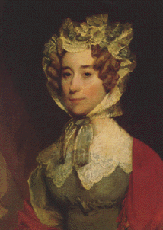|

Louisa Catherine Johnson Adams
1775-1852
[John Quincy Adams]
Biography: Only First Lady born outside the United States, Louisa
Catherine Adams did not come to this country until four years after she had married John
Quincy Adams. Political enemies sometimes called her English. She was
born in London to an English mother, Catherine Nuth Johnson, but her
father was American--Joshua Johnson, of Maryland--and he served as United
States consul after 1790.
A career diplomat at 27, accredited to the Netherlands, John Quincy
developed his interest in charming 19-year-old Louisa when they met in
London in 1794. Three years later they were married, and went to Berlin
in course of duty. At the Prussian court she displayed the style and
grace of a diplomat's lady; the ways of a Yankee farm community seemed
strange indeed in 1801 when she first reached the country of which she
was a citizen. Then began years divided among the family home in Quincy,
Massachusetts, their house in Boston, and a political home in Washington,
D.C. When the Johnsons had settled in the capital, Louisa felt more at
home there than she ever did in New England.
She left her two older sons in Massachusetts for education in 1809 when
she took two-year-old Charles Francis to Russia, where Adams served as
Minister. Despite the glamour of the tsar's court, she had to struggle
with cold winters, strange customs, limited funds, and poor health; an
infant daughter born in 1811 died the next year. Peace negotiations
called Adams to Ghent in 1814 and then to London. To join him, Louisa
had to make a forty-day journey across war-ravaged Europe by coach in
winter; roving bands of stragglers and highwaymen filled her with
"unspeakable terrors" for her son. Happily, the next two years gave her
an interlude of family life in the country of her birth.
Appointment of John Quincy as Monroe's Secretary of State brought the
Adamses to Washington in 1817, and Louisa's drawing room became a center
for the diplomatic corps and other notables. Good music enhanced her
Tuesday evenings at home, and theater parties contributed to her
reputation as an outstanding hostess.
But the pleasure of moving to the White House in 1825 was dimmed by the
bitter politics of the election and by her own poor health. She suffered
from deep depression. Though she continued her weekly "drawing rooms,"
she preferred quiet evenings--reading, composing music and verse, playing
her harp. The necessary entertainments were always elegant, however; and
her cordial hospitality made the last official reception a gracious
occasion although her husband had lost his bid for re-election and
partisan feeling still ran high.
Louisa thought she was retiring to Massachusetts permanently, but in 1831
her husband began 17 years of notable service in the House of
Representatives. The Adamses could look back on a secure happiness as
well as many trials when they celebrated their fiftieth wedding
anniversary at Quincy in 1847. He was fatally stricken at the Capitol
the following year; she died in Washington in 1852, and today lies buried
at this side in the family church at Quincy.



|

